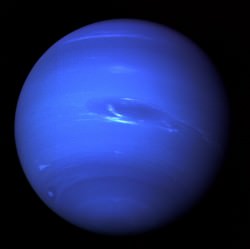Astronomers have directly imaged a brown dwarf companion to the star HD 3651. This star is already known to host an extrasolar planet – less massive than Saturn, but sitting within the orbit of Mercury. HD 3651 is slightly less massive than the Sun, and is located 36 light-years away in the constellation Pisces. The brown dwarf, or HD 3651B, is probably between 20 and 60 Jovian masses, and has a temperature between 500 and 600 degrees Celsius.
Continue reading “Brown Dwarf Companion Seen Directly”
Day and Night on an Extrasolar Planet
NASA’s Spitzer Space Telescope has measured the day and night time temperatures of an extrasolar planet. This planet is located 40 light-years away, circling the star Upsilon Andromedae. It’s classified as a “hot Jupiter”, and orbits its parent star once every 4.6 days. The temperature difference between the day and night sides is enormous – differing about about 1,400 degrees Celsius (2,550 degrees Fahrenheit). Although the planet itself is tidally locked to the star, and always presents one face, its atmosphere probably does swirl around, and distributes the heat somewhat.
Continue reading “Day and Night on an Extrasolar Planet”
Super Earths Emerge From Snowy Conditions
Many extrasolar planets have been discovered circling other stars, a few of which are 5-15 times the mass of the Earth, and thought to be solid like our planet. Astronomers were surprised to find these planets orbiting small, cooler red dwarf stars. Researchers believe these “super Earths” form in the chilly halo of snow, ice and frozen gasses that collect around red stars as they cool. There probably isn’t enough solid material to form rocky planets much larger than Mercury in the star’s habitable zone.
Continue reading “Super Earths Emerge From Snowy Conditions”
Hubble Examines the Closest Known Extrasolar Planet
The Hubble Space Telescope turned its gaze towards a relatively nearby Jupiter-sized world recently. The planet orbits the Sun-like star Epsilon Eridani, which is located only 10.5 light-years away. This makes the planet so close that it could be directly observable by Hubble, and large ground-based observatories. The best opportunity will come in 2007, when the planet makes its closest approach to its parent star, and the reflected light should make it observable with our best instruments.
Continue reading “Hubble Examines the Closest Known Extrasolar Planet”
Hubble Finds Distant Extrasolar Planets
The Hubble Space Telescope has identified 16 stars that could have extrasolar planets. The discoveries were made as part of a new Hubble survey, called the Sagittarius Window Eclipsing Extrasolar Planet Search (SWEEPS). This survey looked at 180,000 stars in the central bulge of the Milky Way – 26,000 light years away. The discovery was made using the transit method, where planets dim their parent stars slightly as they pass in front. Further observations will be needed to actually calculate the mass of the transiting planets.
Continue reading “Hubble Finds Distant Extrasolar Planets”
Are There Oceans on Neptune?

Continue reading “Are There Oceans on Neptune?”
A Closer Look at Planetary Formation
Astronomers have used the European Southern Observatory to map a vast disc of gas and dust surrounding a newly born massive star. The star is called HD 97048, and it’s located in the Chameleon I dark cloud, a stellar nursery 600 light-years away. The central star has 40 times the mass of our Sun, and the surrounding disc stretches 12 times further than the orbit of Neptune in our own Solar System.
Continue reading “A Closer Look at Planetary Formation”
Two Hot New Planets Discovered
An international team of astronomers have turned up two new Jupiter-sized planets orbiting distant stars. These planets are incredibly close to their parent stars; just a fraction of the distance from Mercury to the Sun. Astronomers believe these planets are being eroded by the intense radiation of their stars. The discovery was made using the new SuperWASP program, which looks for stars that dim and brighten on a regular schedule as a planet passes in front of them.
Continue reading “Two Hot New Planets Discovered”
Podcast: In Search of Other Worlds
Look down at your feet. There – you’re looking at a planet. Now look into the night sky and you should be able to spot a few more. After that, spotting additional planets becomes really hard, especially when you’re trying to find them orbiting other stars. This week we discuss the techniques astronomers use to locate distant worlds.
Continue reading “Podcast: In Search of Other Worlds”
Brown Dwarf Discovered in Planetary System
NASA’s Spitzer Space Telescope has directly imaged a small brown dwarf star orbiting a larger star – the first time this has ever been seen. The brown dwarf, HD 3651, is classified as a “T dwarf”, has about 50 times the mass of Jupiter, and orbits about 10 times the distance from the Sun to Pluto. Astronomers theorized that the system contained a brown dwarf, because a Saturn-sized planet had a strangely elliptical orbit; something was tugging on it.
Continue reading “Brown Dwarf Discovered in Planetary System”
